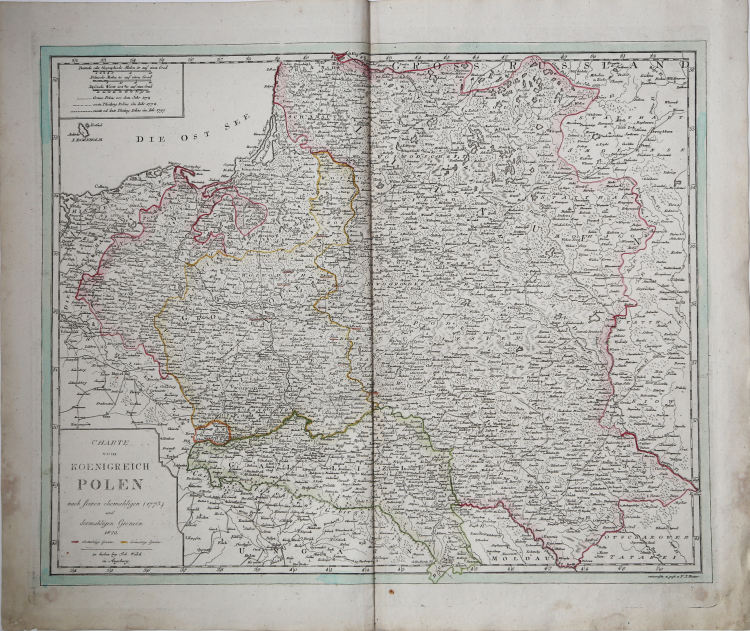



| Reference: | s38523 |
| Author | Johann WALCH |
| Year: | 1820 |
| Zone: | Poland |
| Printed: | Augsburg |
| Measures: | 618 x 525 mm |


| Reference: | s38523 |
| Author | Johann WALCH |
| Year: | 1820 |
| Zone: | Poland |
| Printed: | Augsburg |
| Measures: | 618 x 525 mm |
A very rare map of Poland and Lithuania by Johannes Walch, first published in 1793, here in his sixt – unknown – state, dated 1820. Imago Poloniae (the carthobibliography of the maps form the Niewodniczanski collection, Warsaw 2002) listed only 5 states of the map, the latest with the date 1807.
Copperplate, with fine original outline colouring, light waterstains at the lower corners, otherwise very good condition.
The imperial city of Augsburg was a leading center of map production for Central Europe in the 18th Century. Many of the resident copper engravers such as Johann Stridbeck and Gabriel Bodenehr, and the art publishers Matthäus Seutter and his successor Tobias Conrad, and Johann Michael Probst were specialized in the publication of cartographica and topographica.
The gradual economic recession of Augsburg left its mark on the once flourishing printing and Publishing business. Only Johann Martin Will and especially Johannes Walch prevented the complete disappearance of map production at the end of the 18th Century. The continuity of the Publishing house Walch up until the present time, however, does not guarantee extensive archives for writing a detailed history of a German map publisher. The Publishing house burned down during World War II and most of the written and printed documents were destroyed.
Although Walch and Will also acted as independent publishers in the future, there seems to have been an intimate business combination between the two companies, especially in the area of map production.
Johannes Walch became active from about 1790 as engraver of his own map designs. He published his own sheets, but they also appeared partly in Will. In some cases, both names are equal in the map titles. For example, Walch becomes author and publisher, Will called as publisher.
So early on, the agreement seems to have existed that Walch would be the publisher's successor to his father-in-law. This is also supported by the common home and business address of the two publishers and in particular the fact that Will does not male successor and his inheritance would have to fall anyway to his daughter and her husband Walch. Maps in folio format are the main focus of Walch's cartographic work. Some of them take in the title very specifically, that is sales-promoting, reference to current events of war, such as Poland after its first, and last, or total division - 1796.
Soon, however, his publishing house also found a broad standard program of maps from the regional to the hemispheric map. His engravings are almost entirely editions of foreign originals, and he confessed this only in a few cases in the card title Far more often Walch claimed to have designed a map according to the latest astronomical location rules, most reliable travelogues and most valued resources to have.
Walch, taking into account the taste of the time, completely renounced ornamentation. His maps are clear and fine. They are mostly written in German, partly also in the then fashionable French language.
The large maps by Walch are not part of an Atlas, so they are quite rare on the antiquarian market.
|
Cfr. Imago Poloniae (2002), vol. II, pp. 123-124, K55 77/11 (ed. 1793-1807)
Michael Ritter, Cartographica Helvetica: Fachzeitschrift für Kartengeschichte, nr. 25-26, 2002
|
Johann WALCH Kempten 1757 - Augsburg 1815)
|
After completing a degree in art in Vienna and a two-year stay in Rome, the painter Johannes Walch (1757-1815) from Kempten probably returned to Augsburg in 1785 after spending some time there. In January 1786 he marries Johann Martin Will's eldest daughter Anna Regina and from then on worked in his publishing house. The meeting of Will and Walch in Augsburg should not have been a coincidence, after all, both came from the same city. Will probably Walch's father, a major Kempten merchant and Councilman, who maintained intensive trade relations with Augsburg. A few years after Walch's entry into the office of his father-in-law, the real turning point became map-production without, however, abandoning the other divisions. That the reason for this was probably a personal inclination of Johannes Walch to the map-engraving, is unlikely, because for an academically educated painter, the reproduction and compilation of maps should have offered little scope for free artistic development.
|
|
Cfr. Imago Poloniae (2002), vol. II, pp. 123-124, K55 77/11 (ed. 1793-1807)
Michael Ritter, Cartographica Helvetica: Fachzeitschrift für Kartengeschichte, nr. 25-26, 2002
|
Johann WALCH Kempten 1757 - Augsburg 1815)
|
After completing a degree in art in Vienna and a two-year stay in Rome, the painter Johannes Walch (1757-1815) from Kempten probably returned to Augsburg in 1785 after spending some time there. In January 1786 he marries Johann Martin Will's eldest daughter Anna Regina and from then on worked in his publishing house. The meeting of Will and Walch in Augsburg should not have been a coincidence, after all, both came from the same city. Will probably Walch's father, a major Kempten merchant and Councilman, who maintained intensive trade relations with Augsburg. A few years after Walch's entry into the office of his father-in-law, the real turning point became map-production without, however, abandoning the other divisions. That the reason for this was probably a personal inclination of Johannes Walch to the map-engraving, is unlikely, because for an academically educated painter, the reproduction and compilation of maps should have offered little scope for free artistic development.
|